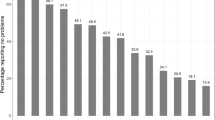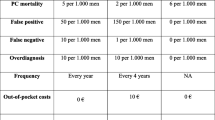Abstract
Objective
To develop a statistical model generating utility estimates for prostate cancer specific health states, using preference weights derived from the perspectives of prostate cancer patients, men at risk for prostate cancer, and society.
Methods
Utility estimate values were calculated using standard gamble (SG) methodology. Study participants valued 18 prostate-specific health states with the five attributes: sexual function, urinary function, bowel function, pain, and emotional well-being. Appropriateness of model (linear regression, mixed effects, or generalized estimating equation) to generate prostate cancer utility estimates was determined by paired t-tests to compare observed and predicted values. Mixed-corrected standard SG utility estimates to account for loss aversion were calculated based on prospect theory.
Results
132 study participants assigned values to the health states (n = 40 men at risk for prostate cancer; n = 43 men with prostate cancer; n = 49 general population). In total, 792 valuations were elicited (six health states for each 132 participants). The most appropriate model for the classification system was a mixed effects model; correlations between the mean observed and predicted utility estimates were greater than 0.80 for each perspective.
Conclusions
Developing a health-state classification system with preference weights for three different perspectives demonstrates the relative importance of main effects between populations. The predicted values for men with prostate cancer support the hypothesis that patients experiencing the disease state assign higher utility estimates to health states and there is a difference in valuations made by patients and the general population.

Similar content being viewed by others
References
Briggs A, Claxton K, Sculpher M. Decision modeling for health economic evaluation. Handbooks in health economic evaluation series. Oxford: Oxford University Press; 2006.
Rentz AM, Kowalski JW, Walt JG, et al. Development of a preference-based index from the National Eye Institute Visual Function Questionniare-25. JAMA Ophthalmol. 2014;123(3):310–8.
Kerr C, Llyod A, Rowen D, et al. Androgen deprivation therapy for prostate cancer prevention: what impact do related adverse events have on quality of life? Health Outcomes Res Med. 2012;3(3):e169–80.
Lloyd AJ, Kerr C, Penton J, et al. Health-related quality of life and health utilities in metastatic castrate-resistant prostate cancer: a survey capturing experiences from a diverse sample of UK patients. Value Health. 2015;18(8):1152–7.
Bharmal M, Thomas J. Comparing the EQ-5D and the SF-6D descriptive systems to assess their ceiling effects in the US general population. Value Health. 2006;9(4):262–71.
von Neumann J, Oskar M. Theory of games and economic behavior. 3rd ed. Princeton: Princeton University Press; 1953.
Gold MR, Patrick DL, Torrance GW, et al. Identifying and valuing outcomes. In: Gold MR, Siegel JE, Russell LB, Weinstein MC, editors. Cost effectiveness in health and medicine. New York: Oxford University Press; 1996. p. 82–134.
Bremner KE, Chong CA, Tomlinson G, et al. A review and meta-analysis of prostate cancer utilities. Med Decis Mak. 2007;27(3):288–98.
Neumann PJ, Goldie SJ, Weinstein MC. Preference-based measures in economic evaluation in health care. Ann Rev Public Health. 2000;21:587–611.
Krahn M, Ritvo P, Irvine J, Tomlinson G, et al. Construction of the patient-oriented prostate utility scale (PORPUS): a multiattribute health state classification system for prostate cancer. J Clin Epid. 2000;53:920–30.
Homberger JC, Redelmeier DA, Petersen J. Variability among methods to assess patients’ well-being and consequent effect a cost-effectiveness analysis. J Clin Epidemiol. 1992;45(5):505–12.
Hadom DC, Uebersax J. Large-scale health outcomes evaluation: how should quality of life be measured? Part I—Calibration of a brief questionnaire and a search for preference subgroups. J Clin Epidemiol. 1995;48(5):607–18.
Gries KS, Regier DA, Ramsey SD, Patrick DL. Preferences for prostate cancer outcomes: a comparison of the patient perspective, the general population perspective, and a population at risk for prostate cancer. Value Health. 2016;19(2):218–25.
Dolan P, Roberts J. To what extent can we explain time trade-off values from other information about respondents? Soc Sci Med. 2002;54(6):919–29.
Robinson A, Dolan P, Williams A. Valuing health status using VAS and TTO: what lies behind the numbers? Soc Sci Med. 1997;45(8):1289–97.
Rosen AB, Tsai JS, Downs SM. Variations in risk attitude across race, gender, and education. Med Decis Making. 2003;23(6):511–7.
Van Nooten FE, Koolman X, Brouwer WBF. The influence of subjective life expectancy on health state valuations using a 10 Year TTO. Health Econ. 2009;18(5):549–58.
Witney AG, Treharne GJ, Tavakoli M, et al. The relationship of medical, demographic and psychosocial factors to direct and indirect health utility instruments in rheumatoid arthritis. Rheumatology. 2006;45(8):975–81.
Brazier J, Roberts J, Deverill M. The estimation of a preference-based measure of health from the SF-36. J Health Econ. 2002;21(2):271–92.
Hanley JA, Negassa A, Edwardes MD, Forrester JE, et al. Statistical analysis of correlated data using generalized estimating equations: an orientation. Am J Epidemiol. 2003;157:364–75.
Burton P, Gurrin L, Sly P. Extending the simple linear regression model to account for correlated responses: An introduction to generalized estimating equations and multi-level mixed modeling. Stat Med. 1998;17(11):1261–91.
Abe Y, Gee KA. Sensitivity analyses for clustered data: An illustration from a large-scale clustered randomization controlled trial in education. Eval Program Plann. 2014;47C:26–34.
Tomlinson G, Bremner KE, Ritvo P, et al. Development and validation of a utility weighting function for patient-oriented prostate utility scale (PORPUS). Med Decis Mak. 2012;32:11–30.
Zhang Y, Zhang B, Wise B, et al. Statistical approaches to evaluating the effect of risk factors on the pain of knee osteoarthritis in longitudinal studies. Curr Opin Rheumatol. 2009;21(5):513–9.
Dolan P, Gudex D, Kind P, et al. Valuing health states: a comparison of methods. J Health Econ. 1996;15:209–31.
Ashby J, O’Hanlon M, Buxton MJ. The time trade-off technique: how do the valuations of breast cancer patients compare to those of other groups? Qual Life Res. 1994;3(4):257–65.
Stolk EA, Busschbach JJV, Caffa M, et al. Cost utility analysis of sildenafil compared with papaverine-phentolamine injections. BMJ. 2000;320:1–6.
Author information
Authors and Affiliations
Corresponding author
Ethics declarations
Funding was provided by the Biobehavioral Cancer Prevention and Control Training Program from the National Cancer Institute (R25CA092408; PI: Donald Patrick). The authors Katharine Gries, Dean Regier, Scott Ramsey, and Donald Patrick have no conflicts of interest in regard to this study. Institutional Review Board approval from the University of Washington and the Fred Hutchinson Cancer Research Center was obtained and the study was performed in accordance with the ethical standards of the Declaration of Helsinki. Informed consent was obtained from all participants included in the study, prior to any study related activities.
Author Contributions
Katharine Gries contributed to the study design, collection of data, statistical analysis, and writing of the manuscript. Dean Regier contributed to the study design, statistical analysis, and writing of the manuscript. Scott Ramsey and Donald Patrick contributed to the study design and writing of the manuscript.
Electronic supplementary material
Below is the link to the electronic supplementary material.
Rights and permissions
About this article
Cite this article
Gries, K.S., Regier, D.A., Ramsey, S.D. et al. Utility Estimates of Disease-Specific Health States in Prostate Cancer from Three Different Perspectives. Appl Health Econ Health Policy 15, 375–384 (2017). https://doi.org/10.1007/s40258-016-0282-x
Published:
Issue Date:
DOI: https://doi.org/10.1007/s40258-016-0282-x




